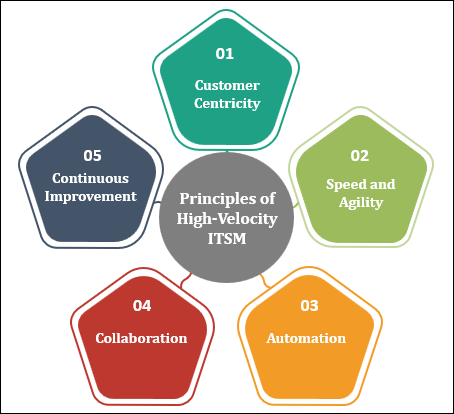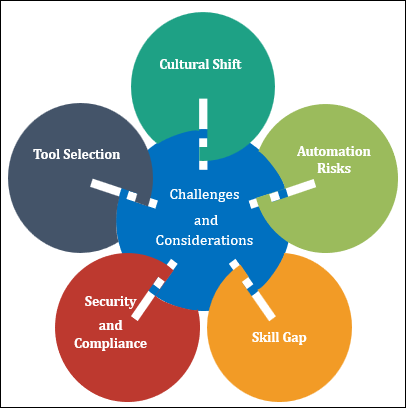HIGH VELOCITY ITSM
In today's fast-paced digital landscape, businesses must adapt quickly to meet the ever-evolving demands of their customers and stay ahead of competitors. This need for speed and agility has led to the emergence of High-Velocity IT Service Management (ITSM), a paradigm shift in how organizations approach IT service delivery.

In this blog post, we will delve deep into the concept of High-Velocity ITSM, its principles, benefits, challenges, implementation strategies, and how it is transforming the future of service management.
Understanding High-Velocity ITSM
High-Velocity ITSM is not merely a reaction to the fast-paced digital environment; it is a proactive strategy to thrive in it. This approach recognizes that the modern business landscape demands swift responses to changing customer expectations and market dynamics. Traditional ITSM practices, with their emphasis on stability and control, can often become bottlenecks in this scenario. High-Velocity ITSM, on the other hand, embraces change and harnesses the power of technology, collaboration, and innovation to stay ahead of the curve.
Inspired by DevOps, Agile, and Lean methodologies, High-Velocity ITSM adopts the principles of these practices to create a dynamic and responsive IT service delivery model. It promotes collaboration across teams, breaking down silos and fostering a culture of shared responsibility. Automation is at the core of this approach, reducing manual effort and allowing IT teams to focus on strategic initiatives. Moreover, it encourages a mindset of continuous improvement, where every process and service is subject to regular assessment and refinement to keep pace with the evolving IT landscape.
Principles of High-Velocity ITSM
- Customer-Centricity: High-Velocity ITSM places the customer at the center of all IT activities. It seeks to understand and meet customer needs and expectations proactively. Customer feedback is used to drive improvements in IT services continually.
- Speed and Agility: Rapid service delivery is a core principle of High-Velocity ITSM. It aims to reduce lead times, minimize bottlenecks, and accelerate the deployment of new features and services. This agility enables organizations to respond quickly to changing market conditions.
- Automation: Automation plays a pivotal role in High-Velocity ITSM. It eliminates manual, repetitive tasks, reduces human error, and enhances efficiency. Automation tools are used for everything from code deployment to incident resolution.
- Collaboration: Collaboration between IT teams and across departments is encouraged. Cross-functional teams work together to achieve common goals, fostering a culture of shared responsibility and knowledge sharing.
- Continuous Improvement: High-Velocity ITSM is built on a foundation of continuous improvement. It encourages regular assessment, measurement, and refinement of processes to drive ongoing enhancement and optimization.
Benefits of High-Velocity ITSM
- Enhanced Customer Satisfaction: By focusing on customer needs and delivering services quickly, High-Velocity ITSM improves customer satisfaction. It aligns IT with business goals, ensuring that IT services contribute to the organization's success.
- Faster Time-to-Market: Rapid service delivery means faster time-to-market for new products and features. This agility is crucial in industries where innovation and competitiveness are paramount.
- Improved Efficiency: Automation reduces manual intervention, streamlines processes, and minimizes errors. This leads to improved operational efficiency and cost savings.
- Better Risk Management: High-Velocity ITSM encourages proactive problem-solving and risk management. By identifying and addressing issues early, organizations can reduce the likelihood of service disruptions and security breaches.
- Empowered Workforce: Collaboration and shared responsibility empower IT teams to take ownership of their work. This fosters a sense of pride, motivation, and accountability among employees.
- Continuous Innovation: High-Velocity ITSM encourages a culture of innovation. Teams are empowered to experiment, take risks, and learn from failures, driving ongoing improvements and innovation.
Implementing High-Velocity ITSM
- Define Clear Objectives: Begin by setting clear objectives for your High-Velocity ITSM initiative. What are you trying to achieve, and how will you measure success? Make sure these objectives align with the organization's overall business goals.
- Develop a Culture of Collaboration: Collaboration is key to High-Velocity ITSM. Encourage cross-functional teams to work together, break down silos, and share knowledge. Foster a culture of open communication and mutual support.
- Invest in Automation: Identify areas where automation can make the most significant impact. Implement automation tools and processes to streamline repetitive tasks and reduce manual intervention.
- Continuous Learning and Improvement: Encourage a mindset of continuous improvement. Regularly review and assess your ITSM processes, gather feedback from customers and teams, and make necessary adjustments.
- Metrics and Measurement: Define key performance indicators (KPIs) to track the progress and success of your High-Velocity ITSM initiative. Use these metrics to identify areas that require improvement.
- Training and Skill Development: Invest in training and skill development for your IT teams. Equip them with the knowledge and tools they need to thrive in a High-Velocity ITSM environment.

Challenges and Considerations
While High-Velocity ITSM offers numerous benefits, it also comes with its set of challenges and considerations:
- Cultural Shift: Shifting from a traditional ITSM culture to a High-Velocity ITSM culture can be challenging. Resistance to change and the need for cultural alignment must be addressed.
- Automation Risks: Overreliance on automation can lead to problems if not properly managed. Organizations must strike a balance between automation and human oversight.
- Skill Gap: High-Velocity ITSM requires a different skill set compared to traditional ITSM. Organizations may need to invest in training and development to bridge skill gaps.
- Security and Compliance: Rapid service delivery should not compromise security or compliance. Organizations must ensure that security measures are integrated into High-Velocity ITSM processes.
- Tool Selection: Choosing the right automation and collaboration tools is critical. Organizations should thoroughly evaluate and select tools that align with their High-Velocity ITSM objectives.
Conclusion
High-Velocity ITSM is a transformative approach to IT service management that prioritizes speed, agility, customer-centricity, and continuous improvement. By adopting the principles of High-Velocity ITSM, organizations can enhance customer satisfaction, accelerate innovation, and stay competitive in today's fast-paced digital landscape.
However, implementing High-Velocity ITSM requires careful planning, cultural alignment, and a commitment to ongoing learning and improvement. As businesses continue to evolve and adapt to changing market conditions, High-Velocity ITSM will play a crucial role in shaping the future of service management. Embracing this approach is not just a choice; it's a necessity in the era of rapid technological advancement.






